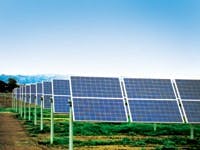Wastewater management systems are essential to public health. Sanitary district managers increasingly are looking for ways to continue offering services despite shrinking budgets.
Renewable energy—solar in particular—helps reduce high operating costs associated with energy use while enabling sanitary districts to continue high levels of service.
Reducing Upfront Costs
Today, solar energy is more affordable than at any time in its 30-year history, and solar panel project economics have improved significantly in the past two to three years. This changes how potential solar customers, including waste managers, should look at solar energy. Recent data from the Solar Energy Industries Association and Greentech Media show that solar panel prices have declined nearly 300% over the past three years.
How can sanitary districts, many of them more than 100 years old, take advantage of the current market and integrate solar systems into their facilities?
The key is knowledge of the tools and services available to manage upfront costs associated with designing and installing a solar system. Solar manufacturers have developed streamlined installation components that lower labor costs and accelerate the completion time of a project.
Beyond the physical hardware, there are a number of incentives available at the local and federal level to help manage upfront costs. For example, California offers performance-based incentives through its state solar energy initiative. Many states offer renewable energy credits as part of their state renewable portfolio standards. A compilation of these incentives can be found at: www.dsireusa.org.
Perhaps the most important innovation in lowering solar panel costs is the power purchase agreement (PPA). A PPA is a financing relationship in which a third-party owns the panels and sells the generated power back to the property owner at a locked-in rate over a set amount of time. These agreements usually result in a locked-in rate that is lower than the utility bill the customer previously paid. PPAs create immediate savings that continue through the life of the lease.
Oro Loma Sanitary District
Oro Loma Sanitary District in California serves as a great example for water and wastewater facilities considering going solar. Established in 1911, the district provides sewage collection services for 46,000 households and 1,100 businesses across seven communities. It treats an average of 10.95 million gal per day for safe disposal or reuse as irrigation. It provides wastewater collection and treatment and recycling for residential and commercial solid waste.
Oro Loma began pursuing solar energy four years ago after an energy audit inspired facility managers to both lower their energy bills and attempt to establish a power generation system that would be 100% self-sufficient.
To start this process, the district turned to a solar services provider. Solar services providers act as the project coordinator, arranging the financing (in this case, a PPA) and equipment selection for the project. This includes selecting panels, balance-of-system components and an installation company. A solar service provider also is responsible for the design and permitting for the system. In return, the solar service provider is the owner of the system.
Unique Challenges
During the solar system design and installation process in Ora Loma, a unique challenge presented itself. Facility managers had included the goal of 100% generation of their energy needs on site to protect the utility district from fungible and rising electricity rates. An existing power generation system had been installed, but the facility had not yet reached its goal of total self-sufficiency from that system. Engineers had to coordinate two power generation systems in order to cogenerate power—but not interfere with each other.
Engineers from Trina Solar, which manufactured the panels, and DRI Energy, a roofing and solar construction company, had to develop a customized solution that accounted for both power generation systems. In the end, the engineers created a fiber-optic interlock that would immediately shut off parts of the solar system should the utility responsible for the existing power generator go down.
While not every facility will face this issue, having the right partners in the “going solar” process is critical. Sanitary districts range in age from a few decades to more than a century old, and working with partners that can provide customized solutions and support for onsite challenges will have an impact on a solar system’s long-term success.
Going Solar
Whether facility managers are forecasting tight budgets in the coming years, looking to reduce operating costs or simply aspiring to become a greener facility, a solar system can achieve those goals. They are more attainable than ever, thanks to lower panel and installation costs, as well as financial structures that hold the line on upfront costs.
Download: Here


